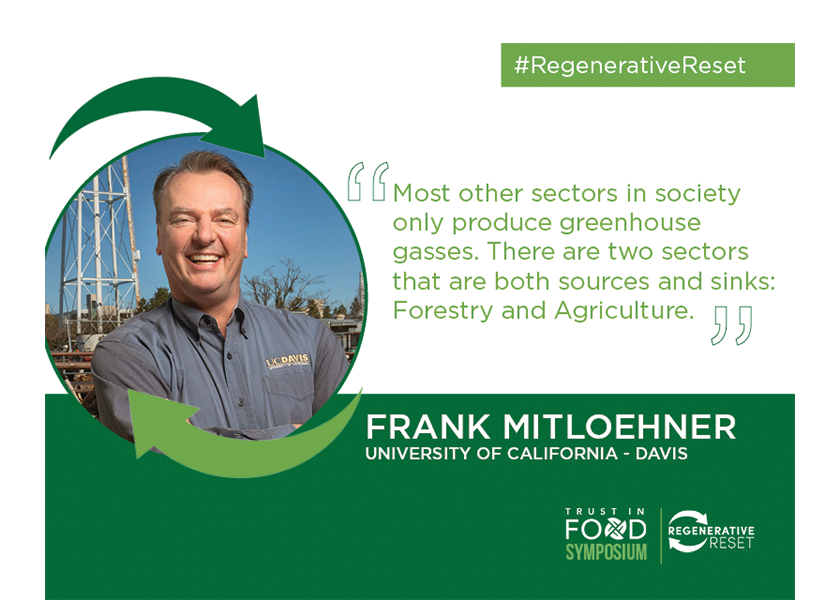Grandin, Mitloehner Serve Up Facts About Animal Ag and Greenhouse Gases

Climate change and sustainability are no longer topics that can be ignored as consumers and policymakers push for action. In a keynote crossover session for the Online Top Producer Summit and Trust in Food Symposium: Regenerative Reset, Colin Woodall, Dr. Temple Grandin and Dr. Frank Mitloehner shared the steps animal agriculture is taking to tackle sustainability. Learn more here.
Animal agriculture gets a bad rap when it comes to sustainability. But that is why it’s vital that the industry take a bigger role in correcting misperceptions and using its voice to be its own best advocate and share the strides it has made over the last few decades, said NCBA CEO Colin Woodall. Modern cattle ranching produces the same amount of beef as was produced in the 1970s, but with a third fewer cattle—a change driven by the industry, without governmental mandates.
“We did so without the EPA telling us to do it, without Congress or the White House telling us to do it. And it's taking that experience, taking that innovation as an industry and showcasing it to everybody,” Woodall said. “But also recognizing that we cannot rest on our laurels. We have to be committed to continual improvement. That's the only way that we're going to be able to be a serious participant at the table, discussing sustainability.”
It goes hand-in-hand with participation from producers. The word sustainability may bring to mind more regulations or burdens on their ranch, Woodall said. But to be sustainable, that narrative has to change. And part of that comes from support from industry leadership, like the NCBA.
“For the NCBA, our first priority with this new strategic plan is to focus on our membership to make sure that they understand that this is about showcasing the stewardship of producers, showcasing what we've already done, in order to make sure that they understand that this is all of us working together, to connect with the consumer, connect with the policymakers, rather than just waiting for somebody to tell us what we have to do.”
Dr. Grandin, a professor of animal science at Colorado State University and a pioneer in farm animal handling and welfare, stressed that as guidelines and processes are set, they must be clear and manageable in the long-term, not just to make a splash in the short-term.
“A few things about sustainability—a care for the environment is definitely is one of them. Then there's the social responsibility where [animal] welfare would be part of that. And then the third thing is people do have to make a living. I want to emphasize make a living, not trying to make a killing,” she said. “The problem with some stuff that’s not sustainable is in the short term you make money, but in the long term you wreck things.”
Dr. Mitloehner, a professor and air quality specialist in cooperative extension in the department of animal science at the University of California, Davis, used his expertise to dispel some of the myths about greenhouse gases related to animal agriculture.
While livestock take a lot of flak for producing methane, the perception is wrong, Mitloehner emphasizes. Anyone who compares cows to cars has been misled into thinking that the two are similar in scale or process, but they’re not.
“In the U.S 80% of all greenhouse gases stem from the use of fossil fuel. And that's transportation, power production/use, and the cement industry,” he said. “Livestock on the other side, in the U.S., emits approximately 4% of all greenhouse gases, according to the EPA.”
In terms of types of greenhouse gases, the methane that livestock produces is considered a flow gas—more is produced, but at the same time it has a much shorter half-life—10 years. So it’s not just produced, it’s also consumed. This is compared to the 1,000 years it takes to remove Co2, which is considered a stock gas. As more is created it’s added to the “stock,” and it’s a cumulative effect.
Another important factor: agriculture is one of the few industries that works as both a source and a sink for greenhouse gases.
“Most other sectors in society only produce greenhouse gases, but there are two sectors that are both sources, and sinks: forestry and agriculture. These land use sectors, forestry and agriculture, take on more carbon than they emit,” he said.
Mitloehner believes as technology changes and the use of things such as anerobic digesters become more commonplace, great strides can be made in a short time. Dairies in California are a prime example. The state passed a mandate to reduce methane emissions by 40% by the year 2030, and in just a few years, they have already reached a 25% reduction.
You can still register for the Online Top Producer Summit, which gives you access to content through March 31. Use the code “ONDEMAND” to take $25 off your registration fee.
Read more coverage of the Top Producer Summit.







